Heating safety group: device, operating principle, selection and installation rules
Human physically Not Maybe All time stay V boiler room For control serviceability lines heating, temperature indicators And level pressure heating device. Main assistants V this question serve additional devices, automatically tracking functioning systems.
We will tell you what devices the group includes security on heating, how they work, how they protect the system. Taking into account our advice, you can easily select the necessary components. The article describes the rules for assembling and connecting this important link, which is responsible for trouble-free operation.
The content of the article:
Security block design
The main reasons for a malfunction in a closed boiler system are increased pressure or excessive filling of the pipeline with coolant, i.e. water. The boiler heat exchanger is the first device to react to such deviations, which is why it fails.
Why might an accident happen?
To prevent such failures in the heating system, a safety unit is used. With its help, the required coolant pressure is achieved in the boiler, pipeline and batteries.
At the moment of excessive pressure, the excess heated coolant is discharged. Emerging emergency situations, such as overheating of a water heating boiler, lead to an increase in pressure in the line. This process is a consequence of exceeding the temperature norm of the coolant.
When heated, the liquid tends to expand, which a closed-type heating system is not designed for - as an additional reserve, it is included in its circuit expansion tank. However, its volume is also limited.
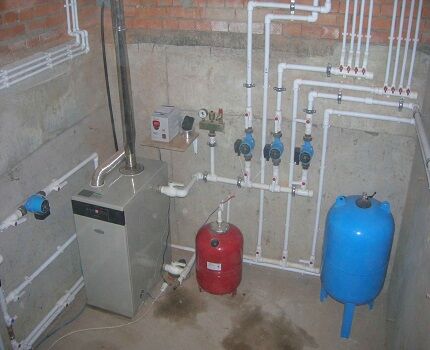
The consequence of increased pressure is failure of boiler elements or rupture of the line. To control the pressure and, in the event of a potentially dangerous situation, adjust it to the optimal value, you will need a mounted safety group.
Structurally, the device is formed from the following modules: automatic air vent, pressure gauge and safety valve. All these devices are mounted in a galvanized steel housing with threaded connectors, with or without thermal insulation.
Automatic air vent
In most cases, the automatic air valve for a security system is made of brass.
Air bubbles in the heating system appear due to the following factors:
- initial filling of the heating line with liquid;
- installation of poor-quality or worn rubber seals;
- blockage with corrosive deposits inside the pipeline;
- water replenishment;
- incorrect installation or commissioning of the heating system, etc.
The water entering the heating circuit contains a lot of oxygen, which, when heated, begins to expand, forming air pockets. Due to their formation, the pressure increases and the coolant circulation rate slows down.
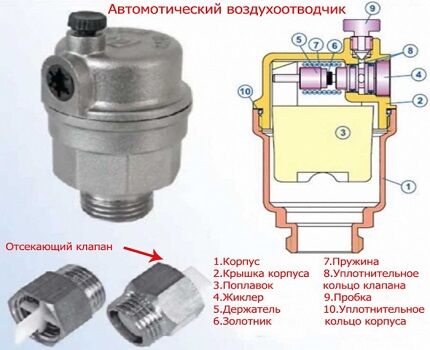
To prevent this from happening, it is advisable to install an automatic air release device, which is easy to use - it does not require adjustment with human intervention.
The principle of operation of the device depends entirely on the design features. The automatic device consists of a channel and a valve. The second element is responsible for removing excess air. If there is no excess pressure in the pipeline, the float is in the raised position, and the needle valve is in the “closed” position.
At the moment an air lock forms, the float will lower and the rocker arm will open the valve - this is how air is released from the system. After removing the excess, the float will return to its original position and the valve will be closed again.
Pressure gauge - an accurate indicator of pressure
The operation of the pressure gauge is designed to measure heating system pressure. This device was created to quickly obtain, check and adjust the acceptable level of indicators. Its main characteristic is the determination of accurate data.
In second place is the quality of reliability. For some, the size of the dial is also important for ease of viewing readings. Each pointer mechanism has its own measurement inaccuracy. This error is scattered as follows: at the edges of the scale it has a maximum value, in the center it has a minimum.
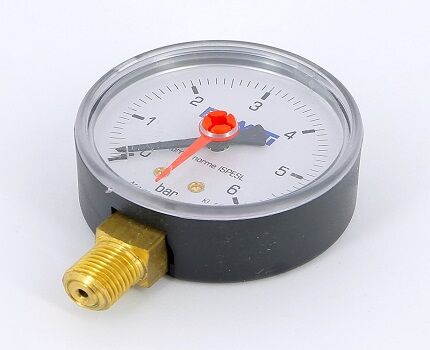
For each heating mechanism, the accompanying documentation specifies the maximum permissible pressure level that it can withstand. Bars or atmospheres are used as measuring units in pressure gauges. However, the first measurement option has become widespread.
Bars have an intermediate meaning and are as close as possible to the physical and technical atmospheres:
- 1 bar = 10.197 m of water column or 0.1 MPa
- Technical atmosphere (1 atm) = 10 m water column
- Physical atmosphere (1 atm) = 10.33 m water column
An indicator of 1.5 atmospheres is the standard pressure value in pipelines independent heating systems. Therefore for autonomous boiler room A pressure gauge with a maximum (end of the scale) of 4 atmospheres will be sufficient.
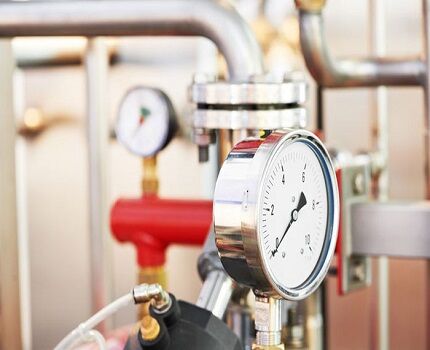
Features of Safety Valve
In the heating system safety valve plays an important role. This is a protective device designed for heat generators. The main function is to eliminate loads (drops) when unplanned situations arise. This problem is most pressing for steam-type heating systems.
However, high blood pressure can also occur due to the following problems:
- Due to a malfunction of the automation, the volume of coolant may exceed the permissible limit.
- Rapid increase in temperature in the circuit.
This device also tends to regulate the flow coolant in the heating line.This is a stamped structure consisting of a brass body equipped with two parts - a membrane and a steel spring. As a rule, at the moment the fuse trips, about 100 g of heated liquid must be eliminated to normalize heating operation.
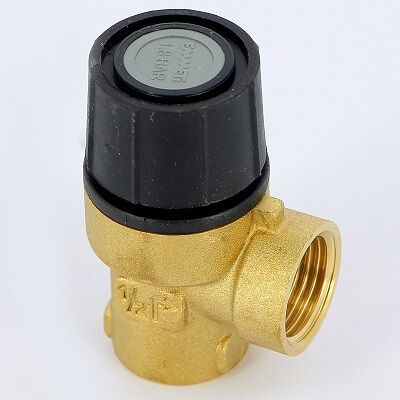
Due to the flexibility of the first element, the required pressure coefficient acting on the membrane is established. Consequently, the membrane partition blocks the passage to the outside. By changing the degree of compression of the spring in the safety valve, the functions of the safety mechanism in the heating system are regulated.
It is necessary to adjust the protective mechanism in such a way that the maximum possible pressure is 15% greater than the working pressure. The valve adjustment process is carried out every year on the eve of the heating season.
The functionality of the device is checked by forcing it to open. This should be done at certain intervals so that the reset mechanism does not become clogged with various deposits while in a non-working position.
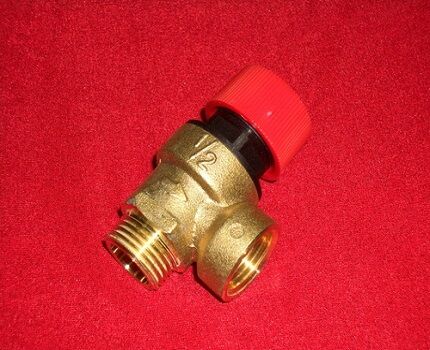
Will familiarize you with the features of the operation and installation of a safety valve for a boiler next article, in which the device is disassembled in detail and wiring diagrams are provided.
Operating principle of the safety unit
The security group works according to an extremely simple scheme, where each of the modules is responsible for maintaining the standards of certain indicators in a private boiler room:
- Thanks to a convenient pressure gauge, the user can monitor the pressure readings at the moment the line is filled with coolant, as well as during the operation of the boiler.
- The safety valve protects the heat generator from critical pressure drops.
- The main functionality of the air vent is based on the automatic release of air entering the pipeline during its initial filling or during operation.
All safety modules are represented by a single unit and are equipped with a special housing - a manifold.
Provided that the boiler room circuit uses an open type expansion tank, installing a safety group does not make sense - the pressure in the pipeline is equal to atmospheric pressure, and excess air leaves the system through the tank capacity.
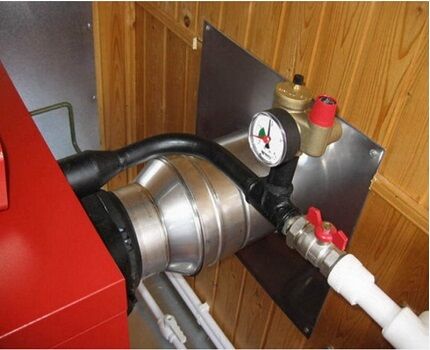
Equipment selection rules
For each model of the protective block, the accompanying documentation specifies the parameters for which it is designed.
The main criteria influencing the choice of device:
- thermal characteristics of the boiler for which the unit is designed, kW;
- maximum coolant temperature, °C;
- nominal pressure;
- compatibility with coolant - water, steam or antifreeze;
- diameter of the connecting thread - if there is a mismatch, it will be enough to purchase adapters of the required diameter.
Correct selection of the power of the safety unit ensures reliable protection of the boiler from any malfunctions in the operation of the heating circuit.
Rating of popular models
Among the manufacturing companies involved in the development of safety valves, the following popular companies can be distinguished: Watts and Valtec. The manufacturer Watts is famous for its fairly extensive range of devices for the heating system, among which the safety unit occupies an important place.
The KSG series has various threaded body devices, differing in their sizes (from standard to compact) and material of manufacture:
- cast iron;
- steel;
- brass.
Additionally, some models come complete with heat-insulating casings. Units from the KSG line are typically equipped with a relief valve designed for a critical pressure of 3 bar. Installation into the heating main is carried out using a 1-inch diameter connector with internal thread.
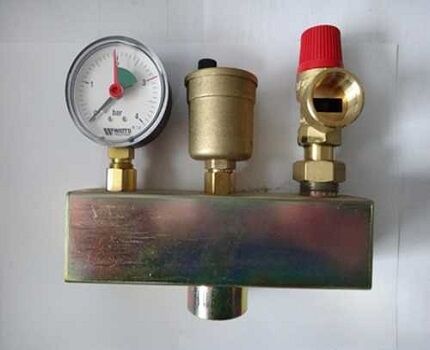
Valtec is not inferior in quality to its products to the previous brand. The company presents a line of devices for boilers and expansion tanks - the VT 460 and VT 495 series, respectively.
The VT 460 model range is designed to operate with domestic heating units with a power of up to 44 kW, at a maximum pressure of 3 bar. However, the prices for ready-made devices are far from cheap, so the solution of self-assembly of such a unit can be called advisable.
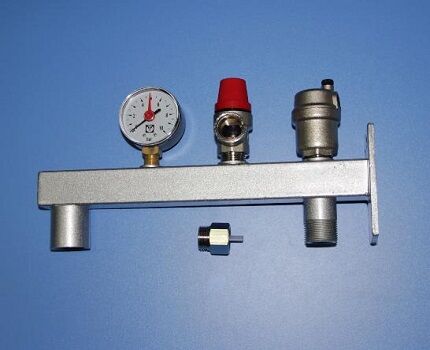
Assembling the security unit yourself
There shouldn't be any difficulties in making the safety unit.
To start the process, you will need to prepare the following modules and tools:
- relief valve;
- pressure gauge;
- air vent;
- wrench;
- gas keys;
- two squares with a threaded connection of external and internal type;
- union;
- crosspiece;
- adapters;
- sealant;
- sanitary flax for sealing and sealing joints.
Initially, the squares must be screwed into the crosspiece. For a tight connection, the flax strands are wound onto the threads in a clockwise direction, and the distribution of the sealant over the surface should be the same.
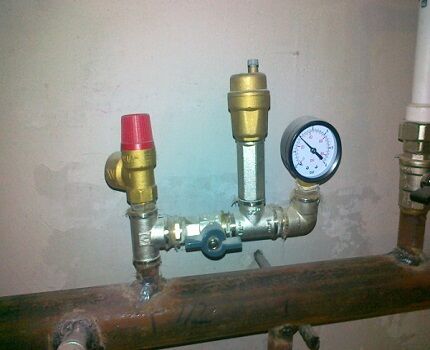
A thin layer of sealant is applied on top of the threads. Next, using a wrench, screw the squares into the crosspiece perpendicular to one another.
Now you need to install the pressure gauge, safety valve and air vent. If parts have different diameters, appropriate adapters are used. After the final assembly of all modules, the operation of the mechanism must be checked under pressure - the device should not leak, and all parts should be in working condition.
Connection to the heating system
First of all, it is necessary to correctly determine the installation location of the security group.
There are certain requirements that must be met:
- this should be a horizontal section of the pipeline next to the heat generator;
- on the supply line after the boiler;
- some boilers provide for installation of a safety unit directly on the unit itself; for this purpose there is a special connector on top of the heat generator;
- the distance from the heating device to the protective block should not exceed 1.5 meters, less is possible;
- for a pipe running vertically upward from the boiler, for example, to the next floor, it is necessary to arrange a branch. This is done using a corner so that the safety group can be positioned in a horizontal plane and the units look “heads up”;
- for a very powerful boiler, it may be necessary to install another protective unit.
A very important rule that must be followed is that shut-off valves are not installed between the safety group and the boiler. It would be advisable to install a protective block up to the first shut-off valve located on the line.

It is worth checking the operation of the safety valve in a timely manner. This procedure is carried out using the following method - after installation, open the cap in the direction indicated by the arrow on the device.
After installing the protective device, it is necessary to check the correct operation of all modules. To start using the air vent, you will need to unscrew the top cap and bleed the air. Now the lid is returned to its original position, but the device must remain slightly open.
Conclusions and useful video on the topic
Video #1. How to assemble a safety group for heating with your own hands:
Video #2.Rules for installing the protective module:
Video #3. Connecting the safety unit to the polypropylene supply pipe:
Many people are sure that the protective unit belongs to ordinary devices and its installation is not mandatory. However, a negligent attitude to this issue will not be able to protect the heating unit and the heating system itself from rupture as a result of a sharp pressure surge, which is a fairly common occurrence in a closed circuit.
Please write comments, ask questions, post photos related to the topic of the article in the block below. Tell us how you equipped your heating circuit with a safety group. Share useful information that may be useful to site visitors.



